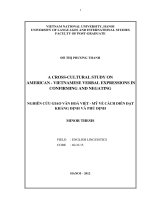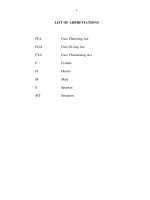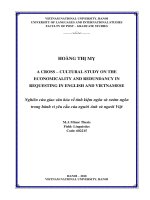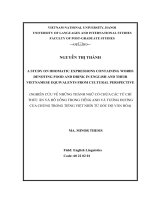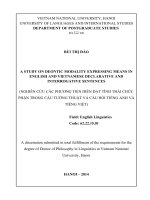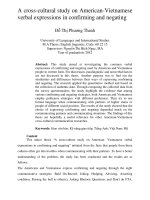A cross cultural study on idiomatic expressions containing numbers in english and vietnamese
Bạn đang xem bản rút gọn của tài liệu. Xem và tải ngay bản đầy đủ của tài liệu tại đây (1.64 MB, 85 trang )
MINISTRY OF EDUCATION AND TRAINING
HANOI OPEN UNIVERSITY
Vu Thi Kim Dung
A cross-cultural study on
idiomatic expressions containing numbers
in English and Vietnamese
NGHIÊN CỨU GIAO VĂN HÓA
NHỮNG THÀNH NGỮ CÓ CÁC TỪ CHỈ SỐ
TRONG TIẾNG ANH VÀ TIẾNG VIỆT
M.A. THESIS
HANOI- 2013
MINISTRY OF EDUCATION AND TRAINING
HANOI OPEN UNIVERSITY
Vu Thi Kim Dung
A cross-cultural study on
idiomatic expressions containing numbers
in English and Vietnamese
NGHIÊN CỨU GIAO VĂN HÓA
NHỮNG THÀNH NGỮ CÓ CÁC TỪ CHỈ SỐ
TRONG TIẾNG ANH VÀ TIẾNG VIỆT
M.A. THESIS
Field : English Language
Code : 60220201
Supervisor : Assoc.Prof. Phan Van Que, Ph.D
HANOI- 2013
Page | i
DECLARATION
Titlle: A cross-cultural study on idiomatic expressions containing
numbers in English and Vietnamese
I hereby declare that no part of the enclosed Master Thesis has been copied
or reproduced by me from any other’s work without acknowledgement and
that the thesis is originally written by me under strict guidance of my
supervisor.
Hanoi, December, 2013
Candidate
Vu Thi Kim Dung
Approved by
Assoc.Prof. Phan Van Que, Ph.D
Page | ii
ACKNOWLEDGEMENTS
My study has been only completed successfully with the assistance and
guidance of my teachers, my friends, and my relatives.
First of all, I would like to express my sincere gratitude to my supervisor,
Assoc. Prof. Phan Văn Quế Ph.D for his valuable suggestions, academic
guidance, critical comments and practical advice on my study.
I am also grateful to all my teachers at the Post-graduate Studies in Hanoi
Open University for their useful lectures which have built in me a firm
foundation with immense ideas for the fulfillment of this paper.
In addition, my thanks also go to my friends with their ideas, material, and
enthusiasm and support to me in all aspects.
Last but by no mean least, I wish to acknowledge the support and invaluable
help of my husband and my family while the work was in progress.
Definitely, I will not be able to do any thing without their help.
Hanoi, December 2013
Vu Thi Kim Dung
Page | iii
TABLE OF CONTENTS
PART I: INTRODUCTION 1
1. Rationale of the study 1
2. Aims and objectives of the study … 2
3. Research questions 2
4. Scope of the study 3
5. Methods of the study.… 3
6. Design of the study 4
PART II: DEVELOPMENT 5
CHAPTER 1: Literature review and theoretical background 5
A. Theoretical background 5
1.1. Idiomatic expressions 5
1.2. Definitions of idioms 8
1.2.1 Definitions of English idioms 8
1.2.2. Definition of Vietnamese idioms … 10
1.3. Classification of idioms 11
1.3.1. English idioms 11
1.3.2. Vietnamese idioms 17
1.4. Specific characteristics of idioms 18
1.5. Numbers in English and Vietnamese cultures 23
1.5.1. Numbers in English culture … 23
1.5.2. Numbers in Vietnamese culture …. 27
B. Literature review of previous studies on idioms … 28
Page | iv
CHAPTER 2: Methodology 30
2.1. Research question 30
2.2. Data collection 30
2.3. Analytical framework 31
2.4. Data analysis 31
2.4.1. The connotative meanings of numbers in English and Vietnamese
idioms… 32
2.4.1.1. Expressing positive meanings … 34
2.4.1.2. Expressing neutral meanings 37
2.4.1.3. Expressing negative meanings 39
2.4.2. Ideational, interpersonal and relational numerical idioms in English
and Vietnamese 45
2.4.3. The frequency of appearance of numbers in English and Vietnamese
idioms 52
CHAPTER 3: Findings and Discussions 59
3.1. Major findings …. 59
3.1.1. From the connotative analysis … 59
3.1.2. From the functional analysis based on the appearance of idioms 60
3.2. Discussions 62
PART III: CONCLUSION AND IMPLICATIONS 65
1. Recapitulation ……… 65
2. Limitations of the study ……. …………… 66
3. Suggestions for implications and further studies 66
REFERENCES … I
APPENDIX I: List of selected English idioms IV
APPENDIX II: List of selected Vietnamese idioms VIII
Page | v
LIST OF TABLES
Table 1: The connotative meanings of numbers in English and Vietnamese
idioms by Spangle and Werner’s model 33
Table 2: List of English idioms containing number one (1) 35
Table 3: List of English idioms containing number nine (9) 37
Table 4: List of English idioms containing number two (2) 38
Table 5: List of English idioms containing number three (3) 40
Table 6: List of Vietnamese idioms containing number three (3) 41
Table 7: List of Vietnamese idioms containing number two (2) 43
Table 8: List of Vietnamese idioms containing number one (1) 45
Table 9: Types of numerical idioms in English and Vietnamese by Fernando’s
model 46
Table 10: English numerical idioms having Vietnamese equivalent expressions
with the same meanings 50
Table 11: English numerical idioms having Vietnamese equivalent numerical
idioms with the same meanings 51
Table 12: The frequency of appearance of numbers in English idioms 54
Table 13: The frequency of appearance of numbers in Vietnamese idioms 56
Page | 1
PART I: INTRODUCTION
1. Rationale of the study
In the world today, there are 5,000 to 6,000 living languages, of which
English is by far the most widely used. According to the statistics of list of
English spoken countries by Nationmaster.com, there are 45 countries in the
world speaking English with approximately 350 million people speak English
as their first language. About the same amount of people use it as a second
language. It is the English language that is used as the language of aviation,
international sport and pop music. 60% of the world's radio stations broadcast
in English and more than half of the world's periodicals are printed in English.
It is also the English language that is used as an official language in 45
countries, and as the language of business, commerce and technology in many
others. The statistics above show that English is now an effective medium of
international communication.
English has been a very important international means of communication in
almost fields of life such as economy, politics, culture and education. The
mastering of English is not an easy matter because it requires a large number
of linguistic issues such as grammar and pronunciation to have effective
communicative activities. Among these issues, vocabulary plays a vital role
due to its meaning creating. In vocabulary teaching and learning, idiom is an
issue with which English learners and teachers are concerned because idioms
are frequently used to make conversations more natural, interesting and
concise in daily communicative activities. Idioms are used to express ideas in
figurative styles. It is true that the more skillfully one uses idioms in his
conversations, the more effectively he can establish his communicative
relationship. Therefore, knowing how to use idioms effectively in the right
Page | 2
situations is becoming essential. It can be said that idioms are the color and
vitality of a language. Thus, the effective use of idioms is a necessary
requirement for any language learners who have desire to master it.
Numbers which are very common in our daily life and have certain cultural
characteristics also appear in idioms. Idiomatic expressions containing
numbers bring about interesting diverse meanings to our utterances and
writings. Personally, in daily life of English and Vietnamese, I see that
numbers have certain significance. People admire some numbers and vice
versa. All of those are factors that give me the inspirations to choose this topic
A cross-cultural study on idiomatic expressions (idioms) containing
numbers in English and Vietnamese. The thesisis expected to be an
interesting and helpful material for foreign language teachers and learners and
for people who are interested in idioms in both English and Vietnamese.
2. Aims and objectives of the study
The thesis, as entitled, focus on idiomatic expressions (idioms only)
containing numbers in English and Vietnamese, gives definitions,
classifications as well as some features of idioms in both English and
Vietnamese. Therefore, the aims of the study are:
• To explore the roles of numbers in the meanings of idioms in English and
Vietnamese.
• To find out the contribution of numbers to the meanings of idioms in
English and Vietnamese; Giving some suggestions to improve knowledge
about English idioms
3. Research questions
In order to achieve these aims, the following matters should be made clear:
• What are the differences of English culture and Vietnamese culture
Page | 3
through the role of numbers in idioms?
• What do numbers contribute to the meanings of idioms in English and
Vietnamese?
4. Scope of the study
In this study, attention is firstly focused on analyzing typical idiomatic
expressions (idioms only) containing numbers in English and Vietnamese
which express English and Vietnamese cultures. Secondly, the study is
focused on revealing what types of English and Vietnamese idioms which
numbers appear in and their connotative meanings in these idioms.
There are some kinds of numbers appearing in idioms: cardinal number and
ordinal number (order number) and in Vietnamese we also have numbers
denoting months of the year. In this study, only English and Vietnamese
idioms containing cardinal number from one (1) to nine (9) are selected and
analyzed.
Because of the size and scope of this thesis, many English idioms containing
ordinal number and other numbers such as ten (perfect ten), zero (zero
tolerance), thousand or million (a thousand times, one in a million) and also
Vietnamese words denoting months of the year (like tháng 3, tháng 4, …) will
not be the subjects of the study.
5. Methods of the study
To achieve the main aims and objectives stated, the study employs both
quantitative and qualitative methods. By virtue of quantitative method, data
have been collected from literary works, books of idioms and semantics and
newspapers, websites and dictionaries in both English and Vietnamese. The
qualitative method is adopted to interpret the collected data.
All the considerations and conclusions are largely based on the analysis of the
Page | 4
statistics data and references.
6. Design of the study
This study consists of three parts, excluding the references.
• Part one, INTRODUCTION, consists of the rationale, the aims, the
research questions, the scope, the methods, and the design of the study.
• Part two, DEVELOPMENT, is the heart of the study which directly deals
with the research on idiomatic expressions containing numbers in English and
Vietnamese to find out the answer for the research questions. This part is
divided into three chapters, including:
Chapter 1: Literature review and theoretical background, provides the
theoretical information about definitions, classification and features of idioms,
brief knowledge about numbers in English and Vietnamese culture, the review
of previous studies on idioms;
Chapter 2: Methodology, is concerned with research questions, data
collection, analysis framework, data analysis;
Chapter 3: Findings and Discussions
• The last part, CONCLUSIONS AND IMPLICATIONS of the study,
includes recapitulation, limitations of the study and some suggestions for
implications and for further studies.
Page | 5
PART II: DEVELOPMENT
CHAPTER 1: Theoretical background and Literature review
A. Theoretical background
1.1. Idiomatic expressions
According to www.thefreedictionary.com, idiomatic expressions are the
expressions whose meanings cannot be inferred from the meanings of the
words that make it up. In other words, idiomatic expressions are types of
informal language that have meanings different from the meaning of the
words in the expression.
Idiomatic expressions include idiom, proverb, phrasal idiom, set
phrase, phrase, locution, saying, etc. In English and Vietnamese language,
idioms and proverbs are widely used. We will focus more on idiom and
proverb.
Oxford Advanced Learner’s Dictionary provides the definition of idiom as “a
group of words whose meaning is different from the meanings of the
individual words.
According to Thành Ngữ Học Tiếng Việt (p.21), “An idiom is a fixed group of
words which is firm in terms of structure, complete and figurative in terms of
meaning, and is widely used in daily speaking”.
A proverb is defined as “a well-known phrase or sentence that gives advice or
says something that is generally true” (Oxford Advanced Learner’s
Dictionary).
Definition by Vu Ngoc Phan (2000) stated that a proverb as “a complete
saying expressing one idea of comment, experience, morality, justice or
criticism”.
Page | 6
It is easy to find that idioms and proverbs have some in common, and until
now there have been no clear-cut borders between them. However, basing on
some criteria, we can distinguish idiom and proverb:
Idiom:
- It is a fixed phrase or other sequence of words;
- It has a meaning beyond or other than the sum of the meaning of the
individual words;
- Idioms do not participate in the usual possible range of variation;
- It is a part of a sentence;
For example:
In English:
- One foot in the grave
- Back to square one
- Be miles away
- Time’s up
- At the moment, etc.
In Vietnamese:
- Ăn gian nói dối
- Biết người biết ta
- Đầu voi đuôi chuột
- Mượn gió bẻ măng
- Quý nhân phù trợ, etc.
Proverb:
- Proverbs must have the clause or sentence structure (not word) to express
justice or an event implying the justice. Sometimes, subject or predicate can
be hidden in proverbs;
- It has a meaning beyond or other than the sum of the meaning of the
Page | 7
individual words;
- Proverbs’ logic contents/meanings are exposed in two ways:
+ It expresses one idea of justice directly (without through actions and
events).
+ It expresses one idea of comment, experience, morality, justice or
criticism basing on an action or an event.
- It can stand independently with a complete meaning.
For example:
In English:
- A burnt child dreads fire
- Where there's a will there's a way
- A friend in need is a friend indeed
- Empty vessels make the most noise
- Great talkers are little doers, etc.
In Vietnamese:
- Ăn quả nhớ kẻ trồng cây, ăn khoai nhớ kẻ cho dây mà trồng
- Ăn kỹ no lâu, cày sâu tốt lúa
- Con trâu là đầu cơ nghiệp
- Có công mài sắt, có ngày nên kim
- Ghét của nào trời trao của ấy
- Mạnh vì gạo, bạo vì tiền
- Người đẹp vì lụa, lúa tốt vì phân, etc.
In conclusion, proverb and idiom has their typical characteristics. Whereas an
idiom is an equivalent unit to a word or a phrase as parts of sentence, a
proverb is a complete sentence or a phrase expressing a full idea. The second
one is the function. A proverb is “a well-known phrase or sentence that gives
advice” and expresses “one idea of comment, experience, morality, justice or
Page | 8
criticism”. As a result, it has perceptive function, aesthetic function and
educational function. On the contrary, idioms have no the three functions
because of not demonstrating judgments, giving advice or stating general
truth about life.
This study, because of its scope and size, concentrates only on the idioms
containing cardinal number (from number 1 to 9).
1.2. Definitions of idioms
1.2.1. Definitions of English idioms
English is very rich in idiomatic expressions. It is difficult to speak or write
English without using idioms. An important fact must be stressed is that
idioms are not only colloquial expressions, as many people believe. They can
appear in formal style and in slang. They can appear in poetry or in the
language of the journalist, the writer and the Bible.
According to Seidl and McMordie (1988), “an idiom is a number of words
which, taken together, meaning something different from the individual words
of the idiom when they stand alone. The way in which the words are put
together is often odd, illogical or even grammatically incorrect”.
For example:
- All rolled up in one
- At sixes and sevens
- In two shakes of a lamb’s tail
- In one fell swoop
- Six feet under, etc
Idioms are composed of more than one word: their constituents show to some
extents of internal cohesion that we expect of single words. An idiom
typically resists interruption and re-ordering of its constituents.
Page | 9
According to Asher and Simpson (1994), idiom, habitual collocation, is a
phrase or other sequence of words which has a meaning beyond or other than
the sum of the meanings of the individual words, and which do not participate
in the usual possible range of variation.
According to Cruse (1986: 37), an idiom is an “expression whose meaning
cannot be inferred from the meanings of its parts when they are not parts of
idioms”.
Fernando (1996) shares the same view of the definition of idioms. At the same
time, he has a broad view when considering idioms as multi-word expressions
whose meanings are not derived from the meanings of their constituents or
their syntactic structures or consist the meaning of one of its constituents
while the other constituent denotes a concept which it does not denote in other
linguistic contexts.
We can see some examples for these views:
- Blow hot and cold
- A fair weather friend
- Knock something off
- Three sheets to the wind
- Nine to five job, etc.
Palmer (1990) defines idioms as group of words whose meaning cannot be
predicted from the meaning of the words themselves. Semantically, idioms are
single units, but they are not single grammatical units like words.
However, grammatically, an idiom does not function like a word. Idioms are
grammatically restricted.
“An idiom is a group of words (or a compound) with a meaning that is different
from the individual words, and often difficult to understand from the individual
Page | 10
words” (Vocabulary in Use Intermediate, p. 26). The meanings of English
idioms are very special. People cannot infer the meaning of an idiom by
working out the meanings of separate constituent elements but rather by
considering the idiom as a whole. In other words, an idiom can be understood
only by grasping its figurative meaning. The literal meaning means nothing.
That is the reason why many English learners often get confused or stuck when
it comes to guessing the meaning of a certain idiom. What Holleman (2006)
remarks in the book entitled “American English idiomatic expressions in 52
weeks” helps confirm this fact. He says that “the use of idioms is a challenge
for English language learners because, compared to standard vocabulary
acquisition, understanding these expressions is not clear by simply referring to
a dictionary.”
Here are some more definitions of idioms:
- “An idiom is an expression which functions as a single unit and whose
meaning cannot be worked out from its separate parts”.
(Longman Dictionary of Language Teaching and Applied Linguistics, p.236)
- “An idiom is a fixed group of words with a special different meaning from
the meaning of several words”
(Dictionary of English Idioms, p.79)
As can be seen from the above definitions, there are different ways of
defining an idiom. In general, most of the linguists share the same point that
an idiom is a fixed expression whose meaning can not be worked out by
looking at the meaning of its individual words.
1.2.2. Definition of Vietnamese idioms
“Vietnamese idioms are fixed expressions in the form of single words or
sentences but totally belong to the spectrum of words. Most of them are
Page | 11
encoded, containing artistic stylization and are only part of an utterance.”
(Thành ngữ là cụm từ mang ngữ nghĩa cố định, chưa tạo thành câu hoàn
chỉnh; không thể thay thế/sửa đổi về mặt ngôn từ; thường được dùng để tạo
thành các câu hoàn chỉnh trong văn nói/viết; số lượng thành ngữ trong tiếng
Việt rơi vào khoảng gần 6 nghìn thành ngữ. Kết cấu của thành ngữ rất khó
(gần như không thể) phân định rõ ràng đâu là chủ ngữ, đâu là vị ngữ)
(Từ Điển Thành Ngữ và Tục Ngữ Việt Nam, p. 659)
According to Thành Ngữ Học Tiếng Việt (p.21), “An idiom is a fixed group of
words which is firm in terms of structure, complete and figurative in terms of
meaning, and is widely used in daily speaking”.
Here are some examples of Vietnamese idioms, which are only part of an
utterance:
- Cá mè một lứa
- An cư lạc nghiệp
- Ba hoa chích choè
- Thả mồi bắt bóng; ….
Idioms are an invaluable treasure of the Vietnamese. “In idioms, we can find
the typical features of people’s thoughts, aesthetics (đẹp như tiên), virtues,
standards of human behaviour (cây ngay không sợ chết đứng) as well as the
attitudes towards the good and the evil (xấu như ma), the noble and the
humble” (Từ Điển Giải Thích Thành Ngữ Tiếng Việt, p.3).
1.3. Classification of Idioms
1.3.1. Classification of English idioms
There are many ways to classify English idioms. Idioms can be classified in
Page | 12
terms of structure, topic and meanings and functions. We will, one by one,
consider each way of classification.
Idioms by topic: There are many topics that express through idioms: Animals,
parts of body, children and babies, fashion, colours, death, food, money,
music, numbers, plants and. flowers, politics, weather,etc.
For example:
- Animals:
+ As blind as a bat
+ As poor as a church mouse
+ Beat a dead horse,
+ The black sheep of the family, etc.
- Food:
+ Big cheese,
+ Born with a silver spoon in one's mouth
+ Buy a lemon,
+ Compare apples and oranges, etc.
- Weather:
+ Rain on my parade
+ Rain cats and dogs
+ Come rain or shine
+ Steal my thunder
+ On cloud nine, etc.
Idioms by structure: According to Cowie, Mackin and Mc Caig (1993) in
Page | 13
Oxford Dictionary of English idioms, Oxford University Express, English
idioms have the enormous structural variety. Basing on functions, idioms can
be also classified as phrase idioms and clause idioms. Seidl – McMordie
(1988), on the other hand, gave eight groups of idioms based on parts of
speech, as follows:
a. Key words with idiomatic uses:
- Adjectives and adverbs:
+ Big fish in a little pond
+ A hard and fast rule
+ As thick as thieves
- Nouns:
+ Out of sight, out of mind
+ The point of no return
+ That the way the cookie crumbles
- Miscellaneous:
+ Once and for all
+ How on earth…?
+ It’s back to the drawing board
b. Idioms with nouns and adjectives:
- Noun phrases:
+ A drop in the ocean
+ The lesser of two evils
+ The pros and cons
- Adjective + noun:
+ A back-seat driver
+ A flying visit
c. Idiomatic pairs:
Page | 14
- Pairs of adjectives: Alive and kicking, sick and tired, spick and span, etc.
- Pairs of nouns: the thrills and spills, the ins and outs, body and soul.
- Pairs of adverbs: first and foremost, more or less, now and again.
- Pairs of verbs: chop and change, sink or swim, live and learn.
- Identical pairs: by and by, over and over, step by step.
d. Idioms with prepositions: above, across, after, against, at, by, for, etc.
+ At first sight
+ For the best
+ Behind the scene
e. Phrasal verbs:
+ Bring something off
+ Fix something up
+ Stand up to someone
f. Verbal idioms:
+ Beat about the bush
+ Catch someone in the act
+ Put down roots
g. Idioms with key words from special categories: this refers to the idioms by
topics: Animals, colours, numbers, parts of the body, time, etc.
- Animals:
+ Lead a cat and dog life
+ Rain cats and dogs
+ Crocodile tears
+ Donkey’s year
- Colours:
+ A black list
+ A bolt from the blue
Page | 15
+ Red tape
+ A white – collar worker
- Numbers:
+ Back to square one
+ One in the thousand
+ Kill two birds with one stone
- Parts of body:
+ Cost someone an arm and a leg
+ See the back of something
+ Keep an eye on something/someone
h. Idioms with comparisons: as … as, like:
+ As busy as a bee
+ As plain as the nose on your face
+ Like the cat that stole the cream
Idioms by meanings and functions: Fernando (1996) divides idioms into
ideational idioms, interpersonal idioms and relational idioms in order to
explore the meanings of idioms and their functions. Based on that, it can be
inferred what the roles of the numbers appearing in idioms are. There are
three types of idioms:
- Ideational idioms: They are idioms either signify message content,
experiential phenomena expressing message contents such as actions, events,
situations (be in a pickle), attributes (matter of fact), evaluations and emotions
(lose one’s heart) or characterizing the message such as showing specific or
non – specific information.
For example, the idiom “have blood on one’s hand” is an idiom to describe a
situation which is “someone must be responsible for someone’s death or is
guilty of causing someone’s death” (Oxford Advanced Dictionary Online).
Page | 16
Another example, the idiom “be in a pickle” is an idiom to describe a
situation. The diomatic meaning is being in a difficult situation.
Ideational idioms convey message contents: actions, events, situations, people
and things, attributes, evaluations, emotions.
- Interpersonal idioms: They are idioms that have interactional function or
characterize the nature of the message, performing interactional strategies
such as greetings and farewells (bye for now, see you later), directives (never
mind, say no more), agreements (that’s true, say no more), eliciting opinions
(what do you think?), rejections (you’re joking).
Interpersonal idioms characterize the message by expressing newsworthiness,
sincerity, calls for brevity, uncertainty.
For example, the idiom “bye for now” is a farewell.
Another example is “say no more” that means “I agree, I will do it; I concede,
no need to continue talking”. Thus it is used to express agreement.
- Relational idioms: these idioms have the function as the coherence, provide
integrative information such as addition (what is more, in addition to) or
comparison (on the other hand, on the other), adversative (on the contrary,
far from), causal (so that when, no wonder), concessive (at the same time).
Relational idioms supply sequencing meta-discoursal information (in the first
place, last but not least) and sequencing temporal information (one day, up to
now).
For example: “in addition to” means “furthermore, besides, moreover”. Thus,
it is an idiom that denotes addition.
Another example is “in the first place” that is an idiom to denote “the
beginning”. It has the function of pointing out the order of information
mentioned. Thus it is called an idiom of sequencing meta – discousal
Page | 17
information.
In this study, we use the classification of idioms by Fernando to analyze the
idiomatic expressions containing numbers in Chapter 2.
1.3.2. Classification of Vietnamese idioms
Nguyễn Lân in the book “Từ Điển Thành Ngữ và Tục Ngữ Việt Nam” stated
that there are five types of idioms which are mentioned below:
- Idioms that contain well-selected words:
+ Văn hay chữ tốt
+ Chim sa cá lặn
+ Nếm mật nằm gai
+ Nghèo rớt mùng tơi, etc
- Comparison idioms:
+ Đẹp như tiên
+ Len lét như rắn mùng năm
+ Nhanh như chảo chớp
+ Ăn quà như mỏ khoét
+ Ướt như chuột lội, etc.
- Idioms with symmetrical structures:
+ Thượng bất chính, hạ tắc loạn
+ Yêu nhau lắm cắn nhau đau
+ Ăn chắc, mặc bền
+ Của thiên trả địa, etc.
- Alliteration idioms:
+ Dở dở ương ương
+ Đi đi lại lại
+ Ù ù cạc cạc, etc.
Page | 18
- Reduplication idioms:
+ Khúc kha khúc khích
+ Lúng ta lúng túng
+ Hí ha hí hửng, etc.
1.4. Specific characteristics of English and Vietnamese idioms
This part focuses on several points of view about specific characteristics of
English and Vietnamese idioms.
First of all, according to Nunberg, Sag & Wasow’s (1994), six characteristics
of idioms are as follow:
• Conventionality: The meanings of idioms can not be deducted from
“knowledge of the independent conventions that determine the use of their
constituents when they appear in isolation from one another”
• Formal inflexibility: The numbers of syntactic frames in which idioms
appear are limited. Thus, idioms are syntactically restricted.
• Figuration: The meanings of idioms are non-literal, or figurative thanks to
the involvement of idioms in metaphors (take the bull by the horns, time as a
substance, time as a path, love as war, and up is more), metonymy (lend a
hand, count heads), hyperboles (not worth the paper it’s printed on).
• Proverbiality: Idioms are used to illustrate familiar situations of social life.
The situations are similar to folksy, familiar images (climbing walls, chewing
the fat, spilling beans).
• Informality: Idioms have a tendency to appear in colloquial speech.
• Affect: Evaluative or affective stances can be inferred from the use of
idioms.
Another opinion should be presented here is that an idiom is a combination of

